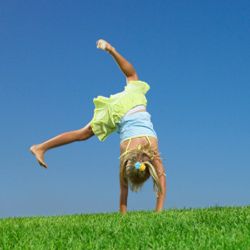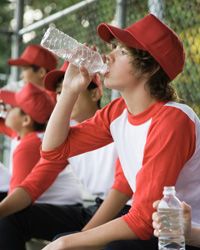 “Summertime, and the living is easy.Victoria Snowber/Digital Vision/Getty Images
“Summertime, and the living is easy.Victoria Snowber/Digital Vision/Getty Images
If you’re a 9-to-5 cubicle dweller, summer has its rewards. The office dress code may relax a bit and the possibility of a vacation to the beach or the mountains looms. The days are longer, which means that it’s still daylight when you leave work, and happy hours on a breezy porch are in session. Yes, summer can be a fun time for even the worker bees, but the real winners when it comes to this sunny season are kids. After all, they’re free from teachers, homework and school lunches. The long days hold nothing but adventures, from backyard baseball games and makeshift forts to trips to the local pool or sleepaway camp. Still, kids and their parents can’t afford to let their guard down when it comes to safety. In fact, more children die from injuries in the warm months than at any other time of the year [source: Brody]. Safe Kids Worldwide estimates that 2.4 million visits to the emergency room and more than 2,100 deaths occur each summer [source: Kotz]. That’s not to say that kids should spend their summer in hermetically sealed bubbles; rather, it’s important to keep a few summer safety tips in mind.
Contents
- Think Before You Eat
- Know Your Limits in the Heat
- Strap on a Helmet
- Police Your Pool
- Wear Sunscreen and Protective Clothing
5: Think Before You Eat
Most adults know that a vacation can wreak havoc on a healthy diet, and kids aren’t exempt from this rule. With months of free time, they can really pack on the pounds — one study found that the body mass index of kindergarteners and first-graders increased two to three times as fast in the summer, compared to the regular school year [source: Parker-Pope]. And it’s not just the overweight who should worry, as the same study found that children who needed to gain weight were unable to do so during the summer. Without the structure of school, children may eat way more or way less than they need to.
While keeping kids on an eating schedule during the warm months can be difficult, another challenge is to keep food safe at the numerous campouts, weddings, picnics and barbecues that take place during the summer. Food left in the sun can spoil, and undercooking those burgers could result in food poisoning. To keep food safe for kids to eat, be sure to wash hands, cook foods thoroughly and throw away food that’s been left out longer than two hours [source: WebMD]. When traveling with food, bring along lots of ice and freezer packs, and keep an eye out for signs of food-borne illness, which include nausea, vomiting and diarrhea. Children, along with pregnant women and the elderly, are particularly at risk for food poisoning.
4: Know Your Limits in the Heat
 “Drink up, especially during summer sports.Andersen Ross/Digital Vision/Getty Images
“Drink up, especially during summer sports.Andersen Ross/Digital Vision/Getty Images
It’s important that kids don’t turn into couch potatoes over the summer, but that doesn’t mean they should be outside all day, every day, particularly in the middle of a heat wave. Young children in particular are at risk for heat exhaustion and heatstroke, both of which cause the body’s cooling system to shut down. Symptoms of mild heat exhaustion include fatigue, cramps and thirst, while more serious cases are indicated by dizziness, nausea and rapid heartbeat.
The most important weapon in the fight against heat exhaustion and heatstroke is water, and plenty of it. Children should drink a glass before they head outside, and once outdoors, they should have a water bottle that they drink from regularly. They may need to be reminded — children have a harder time telling that they’re thirsty than adults do. Also, kids should wear loose-fitting clothing when playing outside. That may seem like a no-brainer, but if your child is headed off to sports camp, it’s important to inquire what gear they’ll be required to wear on hot days.
While physical exertion is one of the main risks for heatstroke, be aware that a child doesn’t even have to be moving to experience the heat’s effects. That’s why it’s important never to leave a child in a parked car during the summer; even with the window open, heatstroke can strike within minutes.
3: Strap on a Helmet
Scooters, skates and bicycles are often banished to the garage during the colder months, but once warmer weather rolls around, they receive a reprieve from their winter resting places. Make sure that the proper safety gear also gets retrieved from the garage, and re-evaluate its condition every year to ensure that it’s still OK to use. Most importantly, any kid who wants to hop on a bike, scooter or skates needs a helmet. It doesn’t matter if the child is riding in the street or an isolated backyard — if the child were to fall, he or she would be at risk for a head injury that could cause concussion or death. In addition to a helmet, many kids benefit from elbow and knee pads.
Simply strapping a child into enough equipment to pad a fall isn’t enough, though. Parents should invest in lessons or a proper training program for kids who skate or bike; often, local community centers will offer classes on biking safety. Young riders should be supervised, even when they’re not on major roads.
2: Police Your Pool
 “If a child can’t swim, don’t rely on floaties or water wings. Use a life jacket instead.Photodisc/Getty Images
“If a child can’t swim, don’t rely on floaties or water wings. Use a life jacket instead.Photodisc/Getty Images
Drowning is the leading cause of accidental death in children younger than 14 [source: Brody]. While oceans, lakes and rivers present a host of challenges, many drownings happen in a parent’s own backyard, often with a parent in attendance. That’s because drowning can happen extremely fast — in the time that you take to turn around, a child could be gone.
If you have a backyard pool, it’s important to fence it adequately. That means that it should be enclosed on all sides by a fence that’s at least 4 feet (1.2 meters) high. The fence should be free of handholds and footholds, and its latch should be high enough that a small child can’t reach it. Many people consider their house to be the fourth wall of this enclosure, but that’s inadequate, particularly in summer when screen doors, which toddlers can open, are in use. If your home does open out onto the pool, consider installing alarms on the door, so that adults are alerted when the doors are opened.
Children should take swimming lessons, while adults should take swimming and water safety classes. However, a lesson isn’t enough to stop a child from drowning, so children must be supervised constantly while they are in the water. That doesn’t mean that an adult can read a magazine or talk on a cell phone while the children splash about — active supervision is key. If the supervising adult needs to take a phone call or a restroom break, children should exit the pool and leave the pool area until the adult can return. These rules may sound draconian, but again, it only takes a few seconds to drown in just a little bit of water.
1: Wear Sunscreen and Protective Clothing
Skin cancer isn’t something you should start to worry about at a certain age — even the very young must be diligent against the risk of sunburns. With just a few bad sunburns under his or her belt, a child younger than age 18 is at double the risk of melanoma later in life [source: Lerche Davis]. To minimize the threat of sunburn, children should always wear a sunscreen with an SPF of at least 30 [source: WebMD]. Sunscreen should be put on about half an hour before the child goes outside and reapplied regularly, even if the product claims to be waterproof. No child, fair-skinned or dark-skinned, should be exempt from this rule.
In addition to lathering on the sunscreen, parents can limit their kids’ exposure to the sun in other ways. First off, stay inside or in the shade between the hours of 10 a.m. and 4 p.m., when the sun’s rays are at their strongest. When in the sun, wear protective clothing; a T-shirt in any color other than white will provide a safeguard. You may also want to invest in protective swimwear, such as wetsuits that cover the elbows and knees. And don’t forget the accessories: Brimmed hats and sunglasses play an important role in shielding your young one from the sun.
Lots More Information
Related HowStuffWorks Articles
- Top 5 Winter Safety Tips for Kids
- Top 10 Safety Tips for Kids
- How Halloween Safety Works
Sources
- "Bicycle Safety." WebMD. (Oct. 26, 2009)http://firstaid.webmd.com/bicycle-safety
- Broadwell, Laura. "6 Summer Safety Rules." Parents. (Oct. 26, 2009)http://www.parents.com/kids/safety/outdoor/6-summer-safety-rules/
- Brody, Jane E. "Children’s Safety Often Neglected in Cars." New York Times. March 7, 2000. (Oct. 26, 2009)http://www.nytimes.com/2000/03/07/health/personal-health-children-s-safety-often-neglected-in-cars.html
- Brody, Jane E. "Going Beyond the Obvious For a Summer Safety Camp." New York Times. June 1, 1999. (Oct. 26, 2009)http://www.nytimes.com/1999/06/01/health/personal-health-going-beyond-the-obvious-for-a-safer-summer-camp.html
- Brody, Jane E. "Of Swimming, Jumping and Summer Safety." New York Times. June 18, 2002. (Oct. 26, 2009)http://www.nytimes.com/2002/06/18/health/personal-health-of-swimming-jumping-and-summer-safety.html
- Brody, Jane E. "Personal Health." New York Times. June 29, 1994. (Oct. 26, 2009)http://www.nytimes.com/1994/06/29/us/personal-health-530093.html
- Brody, Jane E. "Save a Child’s Brain: Require a Helmet." New York Times. May 1, 2001. (Oct. 26, 2009)http://www.nytimes.com/2001/05/01/health/personal-health-save-a-child-s-brain-require-a-helmet.html
- Brody, Jane E. "Water Safety is a Summertime Essential." New York Times. July 25, 2006. (Oct. 26, 2009)http://www.nytimes.com/2006/07/25/health/25brod.html
- Kotz, Deborah. "12 Ways to Childproof Your Kids’ Summer." U.S. News & World Report. July 2, 2007.
- Lerche Davis, Jeanie. "Summer Skin Care for Kids." WebMD. (Oct. 26, 2009) http://www.webmd.com/parenting/features/summer-skin-care-kids
- Mann, Denise. "Beach Safety 101." WebMD. (Oct. 26, 2009)http://www.webmd.com/parenting/features/beach-safety-101
- O’Neill, Catherine. "Safer Summers." Washington Post. May 26, 1992.
- Parker-Pope, Tara. "School is Out, and Nutrition Takes a Hike." New York Times. June 24, 2008. (Oct. 26, 2009)http://www.nytimes.com/2008/06/24/health/nutrition/24well.html
- Purdy, Matthew. "Don’t Go in the Water, or the Sun, or the Shade, Or…" New York Times. July 8, 2001. (Oct. 26, 2009)http://www.nytimes.com/2001/07/08/nyregion/our-towns-don-t-go-in-the-water-or-the-sun-or-the-shade-or.html
- Romano, Jay. "Your Home; Don’t Give Safety a Vacation." New York Times. July 19, 1998. (Oct. 26, 2009)http://www.nytimes.com/1998/07/19/realestate/your-home-don-t-give-safety-a-vacation.html
- Rosen, Margery D. "Your Guide to Water Safety." Parents. (Oct. 26, 2009)http://www.parents.com/baby/safety/outdoor/water-safety/
- "Summer Safety for You and Your Children." WebMD. (Oct. 26, 2009)http://children.webmd.com/primer-on-summer-safety
- Vogin, Gary D. "Pool & Spa Hazards for Children." WebMD. July 21, 2009. (Oct. 26, 2009)http://children.webmd.com/pool-spa-hazards



































